

WorstPolluted.org : Reports. Pollution. Pollution is the introduction of contaminants into the natural environment that cause adverse change.[1] Pollution can take the form of chemical substances or energy, such as noise, heat or light.

Pollutants, the components of pollution, can be either foreign substances/energies or naturally occurring contaminants. Pollution is often classed as point source or nonpoint source pollution. Ancient cultures Air pollution has always accompanied civilizations. Pollution started from prehistoric times when man created the first fires. Official acknowledgement King Edward I of England banned the burning of sea-coal by proclamation in London in 1272, after its smoke became a problem.[4][5] But the fuel was so common in England that this earliest of names for it was acquired because it could be carted away from some shores by the wheelbarrow.
It was the industrial revolution that gave birth to environmental pollution as we know it today. Modern awareness. Helping EPR A1 Operators improve their resource efficiency. Issue The UK’s economy and businesses depend on global trade and resources.
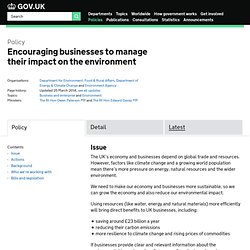
However, factors like climate change and a growing world population mean there’s more pressure on energy, natural resources and the wider environment. We need to make our economy and businesses more sustainable, so we can grow the economy and also reduce our environmental impact. CRC Energy Efficiency Scheme. Overview The Carbon Reduction Commitment (CRC) Energy Efficiency Scheme is a UK government scheme.

It’s designed to improve energy efficiency and cut carbon dioxide (CO2) emissions in private and public sector organisations that are high energy users. The Environment Agency administers the scheme for the UK and regulates the scheme in England. The Scottish Environment Protection Agency, Northern Ireland Environment Agency and Natural Resources Wales regulate the scheme in their own countries. Energy already covered under climate change agreements and the EU Emissions Trading System is not included in CRC. Some public bodies must take part in CRC regardless of how much electricity they use.
CRC operates in phases. For each phase, there is a qualification year. Organisations affected by CRC have to register with the Environment Agency at the start of a phase, for the whole phase. In each compliance year, an organisation that has registered for CRC needs to do the following: CRC Registry. Business and industry. Pollution Inventory. You must monitor your emissions once you get an environmental permit - either continuously or periodically, depending on the conditions of your permit.
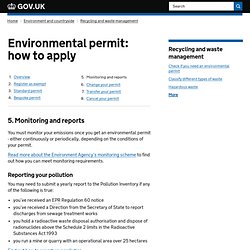
Read more about the Environment Agency’s monitoring scheme to find out how you can meet monitoring requirements. Reporting your pollution You may need to submit a yearly report to the Pollution Inventory if any of the following is true: you’ve received an EPR Regulation 60 notice you’ve received a Direction from the Secretary of State to report discharges from sewage treatment works you hold a radioactive waste disposal authorisation and dispose of radionuclides above the Schedule 2 limits in the Radioactive Substances Act 1993 you run a mine or quarry with an operational area over 25 hectares Find out how to report your pollution. Trading your emissions You may be able to trade your annual allowances for certain emissions with other plants under the National Emissions Reduction Plan (NERP).
Find out if you are eligible. National Pollutant Release Inventory - Air Pollutant Emission Summaries and Trends. Pollution and Waste - Glossary. Through the National Pollutant Release Inventory, Environment Canada tracks pollutant releases, disposals and transfers for recycling of over 300 pollutants from industrial and other facilities.
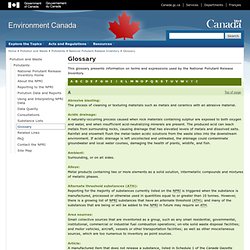
For 17 of these pollutants, Environment Canada also compiles air emission estimates for non-industrial sources such as motor vehicles, residential heating and agriculture. Combined, this information provides a complete picture for air emission sources of these key air pollutants. The key air pollutants are the main pollutants that contribute to smog, acid rain and poor air quality, or are of particular concern to human health and the environment due to their persistence, bioaccumulation and toxicity. Information for these pollutants is also required to fulfill international reporting obligations. Pollution and Waste - NPRI Datasets.
There are a number of factors to keep in mind when using and interpreting National Pollutant Release Inventory (NPRI) data.
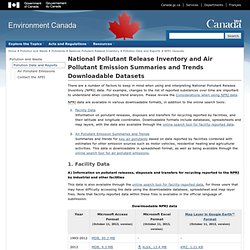
For example, changes to the list of reported substances over time are important to understand when conducting trend analysis. Please review the Considerations when using NPRI data. NPRI data are available in various downloadable formats, in addition to the online search tools: Pollution and Waste - Pollution Data Library. Pollution Data and Reports Tools and resources for accessing, analyzing and interpreting National Pollutant Release Inventory (NPRI) data on pollutant releases and transfers in Canada.
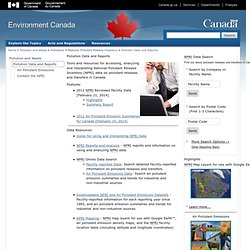
Features Data Resources Guide for Using and Interpreting NPRI DataNPRI Reports and Analysis - NPRI reports and information on using and analyzing NPRI data.NPRI Online Data Search Facility-reported Data: Search detailed facility-reported information on pollutant releases and transfers.Air Pollutant Emissions Data: Search air pollutant emission summaries and trends for industrial and non-industrial sources.Downloadable NPRI and Air Pollutant Emissions Datasets - Facility-reported information for each reporting year since 1993, and air pollutant emission summaries and trends for industrial and non-industrial sources.NPRI Mapping - NPRI map layers for use with Google Earth™, air pollutant emission density maps, and the NPRI facility location table (including latitude and longitude coordinates) NPRI Data Search.
Pollution and Waste - Tracking Pollution in Canada. Category:Pollution by country. Category:Pollution. Construction Waste Management. Home > Construction Waste Management by Tom Napier, Research ArchitectU.S.
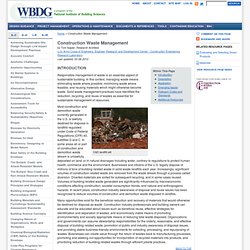
Army Corps of Engineers, Engineer Research and Development Center / Construction Engineering Research Laboratory Last updated: 03-06-2012 Introduction Responsible management of waste is an essential aspect of sustainable building. C&D landfill cell Most construction and demolition waste currently generated in the U.S. is lawfully destined for disposal in landfills regulated under Code of Federal Regulations (CFR) 40, subtitles D and C. Many opportunities exist for the beneficial reduction and recovery of materials that would otherwise be destined for disposal as waste. Description Effective management of building-related waste requires coordinated action of governmental, business, and professional groups and their activities. Management of building-related waste is expensive and often presents unintended consequences.
Eliminating Waste Some waste generated in the process of construction can be eliminated. A. B.